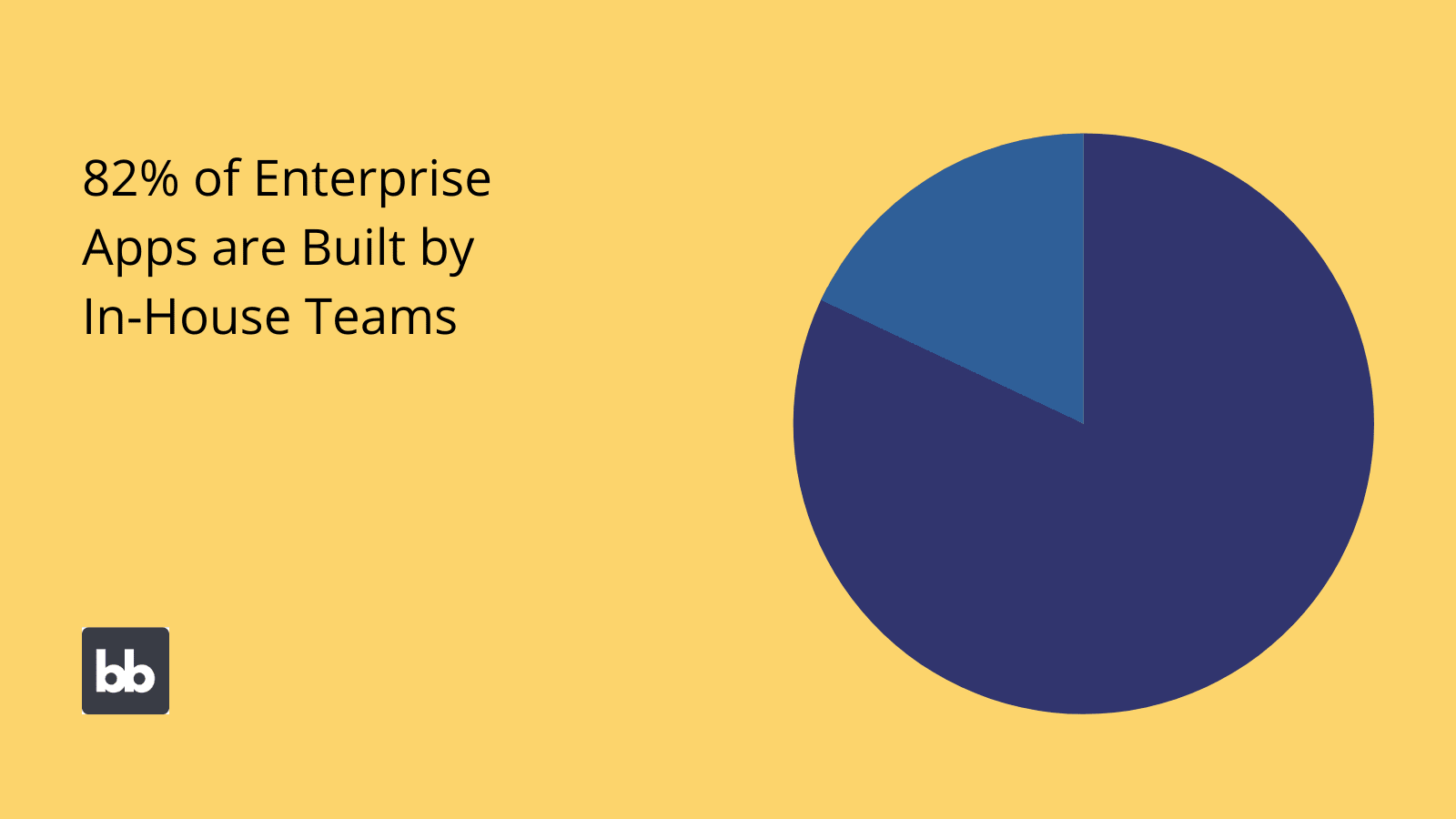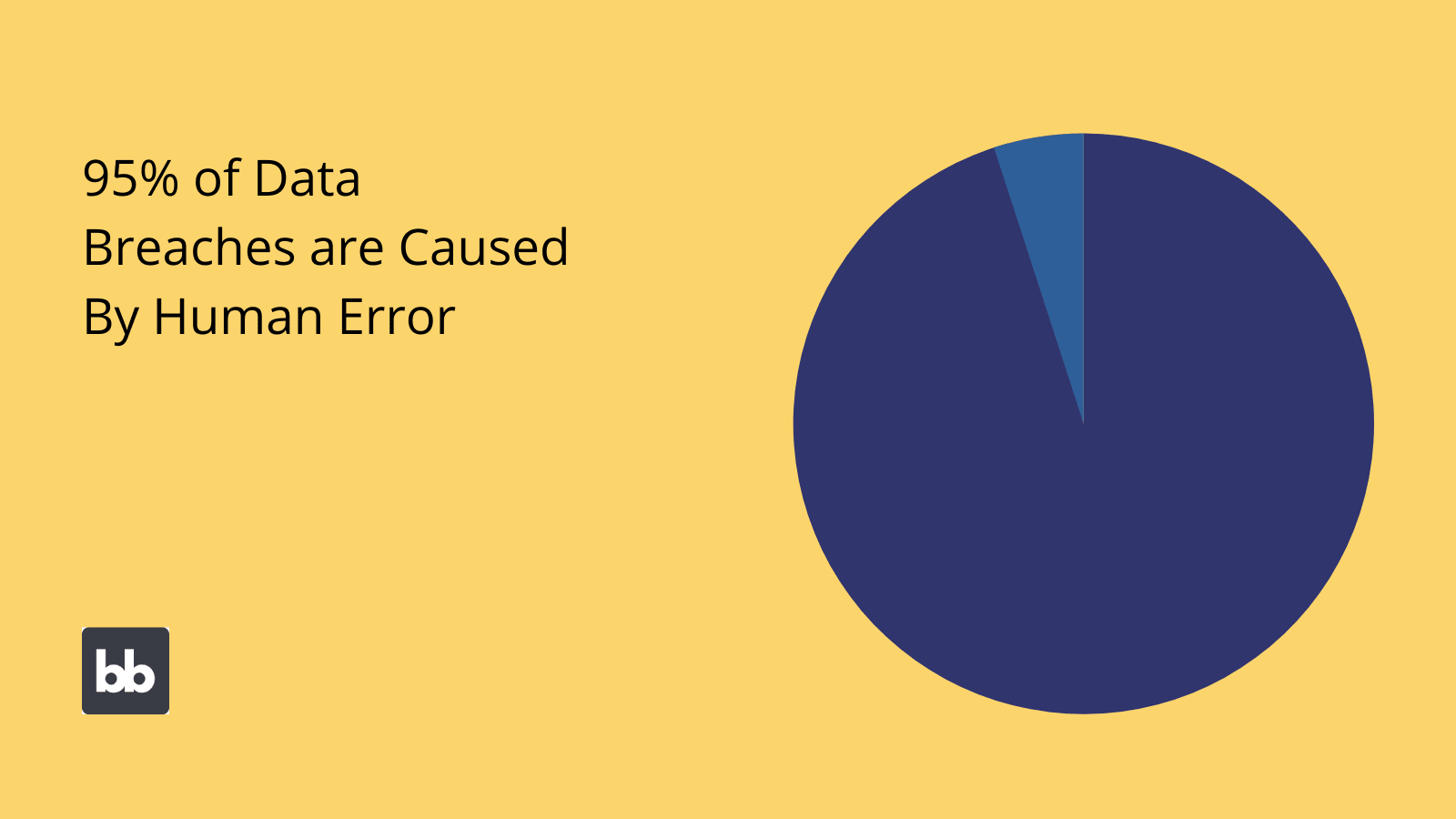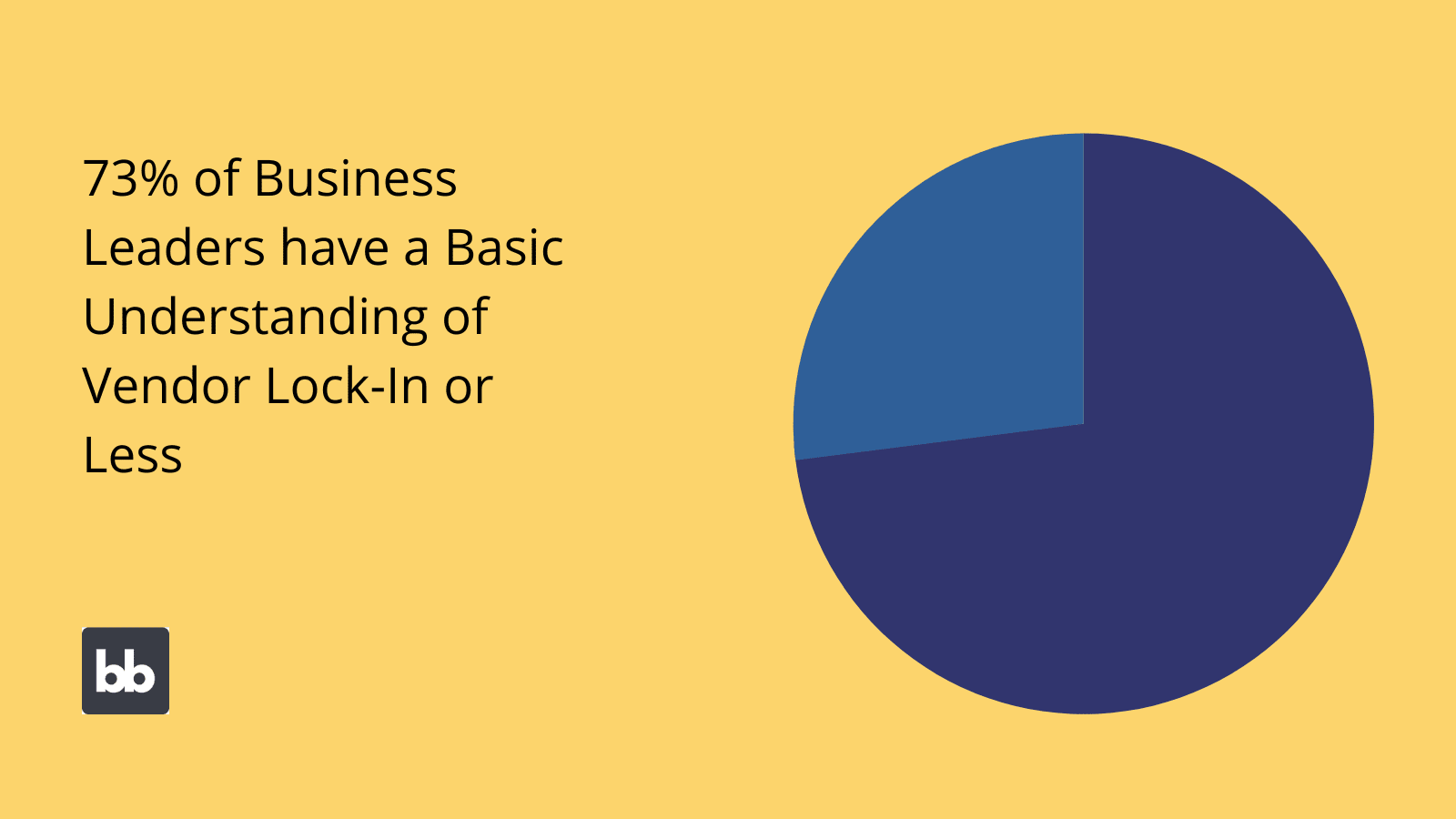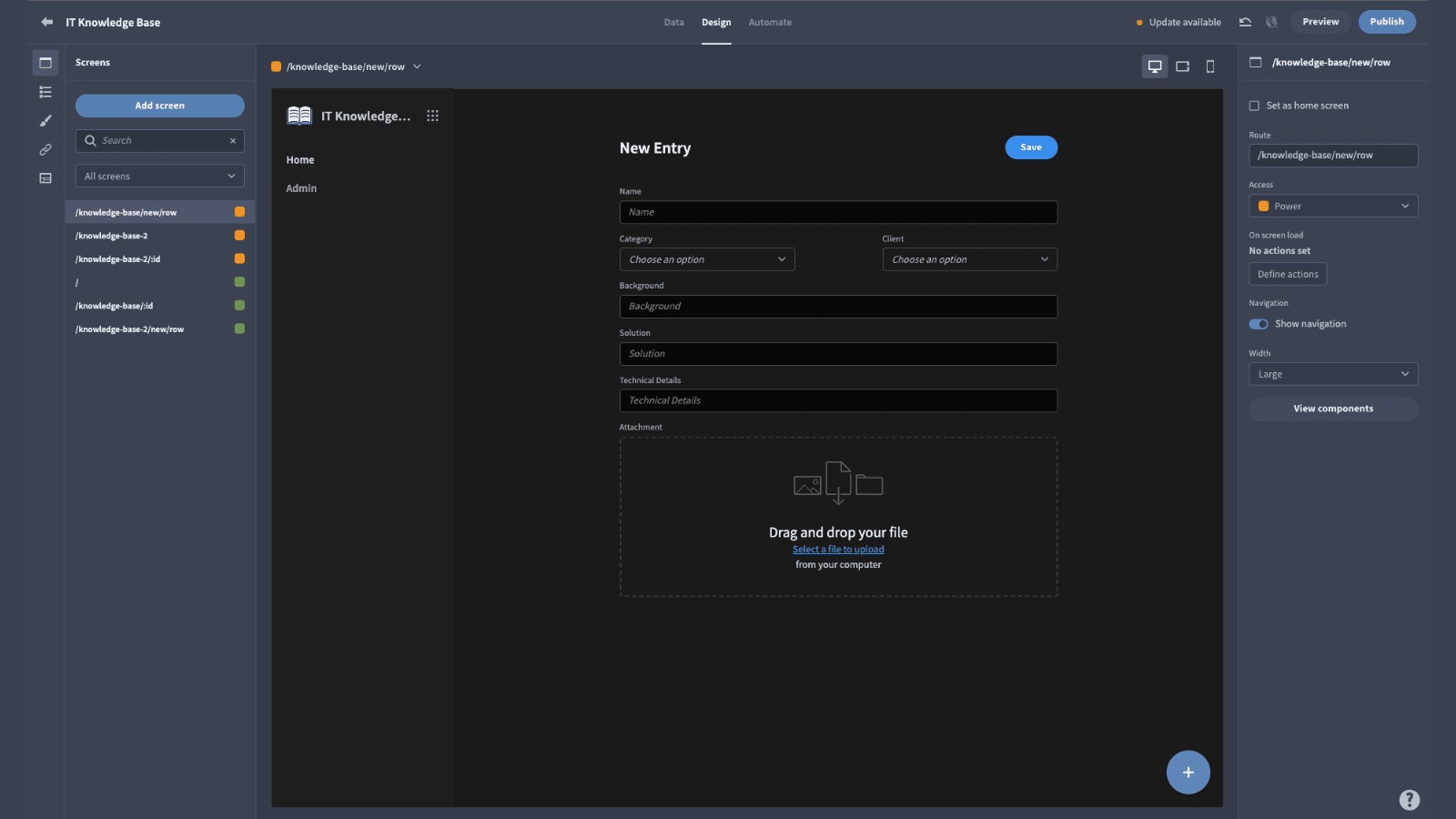Enterprise Software Development | Ultimate Guide
Enterprise software development is uniquely challenging. After all, balancing complex security, systems design, and process mapping with the need to provide efficient, intuitive user experiences is quite an ask.
As such, building enterprise software solutions is really a specialism in itself.
Whether this means relying on your in-house team or engaging with external contractors and development houses, enterprises are often faced with difficult, complex software lifecycles and expensive, lengthy, builds.
That’s if a project ever makes it to the top of the backlog.
Today, we’re diving deep into everything you need to know about effective enterprise software development.
Along the way, we’ll check out the key considerations, challenges, pain points, and opportunities that you’ll need to contend with. We’ll also check out some of the ways that modern enterprises are changing the landscape here.
First, though, we need to start with the basics.
What is enterprise software development?
Enterprise software development is, unsurprisingly, any process for large, international organizations to build or procure custom software solutions. So, really any tools built by enterprises themselves, or for them by third parties.
So why is this even worth mentioning?
Enterprises operate in a completely different context from SMEs. There are a few obvious factors at play here. One is, naturally, the sheer size of the organization. An enterprise platform might need to facilitate thousands or even hundreds of thousands of internal users.
There’s also the issue of security. In cyber terms, enterprises have a huge target on their backs. Therefore, they’re at an increased risk of data theft, ransomware, and other attacks.
On top of this, we need to consider the unique ways that enterprises must contend with resourcing projects. The crux of the issue is that IT teams in large organizations are tasked with building so many solutions. It’s normal to end up with lengthy backlogs.
Similarly, there’s a greater impetus to build efficiency into finished solutions.
Since workflows and processes are actioned at such high volumes, even minor inefficiencies can result in huge costs.
We’ll return to the more concrete implications of each of these issues a little bit later. For now. It’s enough to understand them as contextual issues for enterprise software development.
With these in mind, we can start to think more specifically about the operational and process-level side of building enterprise software.
How do enterprises build software solutions?
Unsurprisingly, there isn’t a single straightforward answer here. Rather, there’s a large amount of variance both across and within enterprises. That is, different approaches, frameworks, and methodologies can be used, based on a range of contextual factors.
These include the nature and complexity of the tools being built, the kinds of users they’re aimed at, any extra security concerns or compliance requirements around the data model, and much, much more.
Let’s walk through the broad categories of enterprise development projects, with a specific focus on what each brings to the table and when you might opt for them.

(McAfee )
Check out our guide to enterprise software industry trends .
In-house developments
In-house developers are the backbone of every modern enterprise. In fact, you can make a pretty strong case that any successful enterprise is also a software company - no matter what its core business is.
However, it’s also no secret that finding, recruiting, and training skilled developers is getting harder by the day. So, in-house development teams are under incredible pressure.
As such, resource allocation for development projects becomes a real challenge.
Of course, there’s a tension between this fact and the reality that you’re in-house developers are almost invariably the best positioned to effectively comprehend and solve your business problems.
With limited hours in the day to build, manage, and maintain solutions, the issue becomes deciding what projects to prioritize.
We’ll also return to some of the specific methodologies and tools used by in-house enterprise developers a little bit later.
External custom builds
Of course, the obvious alternative is engaging contractors or specialist custom vendors to build solutions. On the one hand, this is an obvious way to get around the issue of struggling to resource projects internally.
On the other, it introduces a whole raft of new challenges.
For one thing, large, international organizations can’t work with just any vendor. Internal vetting procedures for offering services to enterprises are notoriously difficult. This cuts across issues like compliance, security, finances, lifecycle management, and scenario planning.
For instance, you might face highly specific certification requirements for software vendors.
Then there’s the issue of speed. It’s no secret that enterprises can be slow-moving beasts.
By the time legal, finance, and operations teams have their say, tendering, negotiation, and sign-off processes can take months or even years. That’s before a single line of code can ever be written.
Obviously, none of this is to say that engaging external parties for enterprise software development isn’t a viable option. Only that it too is fraught with challenges and potential for delay.
Enterprise configurations for existing tools
Of course, enterprises also use off-the-shelf solutions for various problems. Most of the time though, this looks quite different from how SMEs license existing tools. Specifically, there’s still typically a significant need for configuration and customization.
This can take a few different forms:
- Enterprise versions offered by the vendor themself.
- Custom configurations created by third parties, based on existing tools.
- Internal configuration projects, based on open-source platforms.
For example, a suitable solution might already exist in terms of functional requirements, but enterprise customers might have additional needs, like implementing their own SSO system or deploying a tool to their own infrastructure.
We’ll return to some of the more specific calculations that arise here when we talk about build vs buy decisions a little bit later.
Citizen development
More recently, citizen development has emerged as an alternative to traditional software procurement processes. Essentially, this means empowering your non-developers to build solutions for their own problems, in specific, limited circumstances.
Normally, citizen developers are technical employees in other departments or non-developers within your IT team. The idea is to relieve pressures on your in-house developers, by giving these kinds of colleagues the tools they need to create simple, common solutions.
So, if someone in your operations team needed a CRUD app built, they could do it themself, rather than waiting for IT to find the time to do it for them.
Check out our ultimate guide to working with citizen developers for a fuller discussion of this.
Low-code for enterprises
Low-code is increasingly becoming a core part of enterprise software development, in the hands of IT teams, citizen developers, and non-technical colleagues alike.
But why?
The reality is that the majority of internal software projects are relatively simple solutions, aimed at digitalizing discrete workflows. So, internal developers build similar tools, over and over again.
Therefore, we can alleviate the burdens placed on overstretched developers by making it faster and easier to build simple solutions.
Later, we’ll return to how Budibase is leading the charge in the low-code revolution.
How do enterprise solutions differ from SMEs?
Now that we have a firmer grasp of the context surrounding enterprise software development, we can think more concretely about the requirements for the tools they actually build.
In other words, what are the characteristics of effective enterprise solutions?
We often hear vendors talking about ‘enterprise features’, but can we really generalize here? If so, what kinds of features do enterprises need, and why?
Take a look at our guide to enterprise app development .
Here’s what you need to know.
Hosting
Hosting is one of the areas where enterprises display the starkest difference in their requirements, owing both to the scale of their operations and the unique set of security risks they face.
So, SMEs might rely on public cloud services to host their systems, but this would be highly unusual in an enterprise context.
Instead, it’s much more common for enterprise software solutions to be self-hosted, either on local networks or private cloud infrastructure.
The goal is to safeguard uptime, access control, integrity, and reliability.
Access control and authentication
Another key challenge is managing large volumes of users, without creating excessive admin burdens for your IT team. There are a couple of components to this problem.
First, we need to reflect the fact that different users interact differently with your software stack. We need an efficient way to manage and assign access to individual users.
Check out our ultimate guide to role-based access control for more information on how this works in practice.
Besides this, we have the challenge of authenticating users.
Remember, enterprises might easily have hundreds of custom internal tools, each one for a dedicated function. Again, without the right systems in place, managing this would create a mountain of administrative work.
Therefore, SSO is critical for making it easy to grant users easy access to the exact tools they need to perform their daily responsibilities.

(Comptia )
Oversight, transparency, and usage monitoring
We also need to be extra conscious of how we can monitor how different users interact with tools, as well as more technical issues relating to usage and capacity.
This cuts across security, resource allocation, and data integrity.
Auditing is central to this.
That is, programmatic logs of both user actions and automation runs. This provides a clear record of how different resources have been used, transformed, and manipulated, which is critical for preventing, triaging, and resolving issues.
Automation
Modern enterprises are built on automation. In fact, automation has a role to play in every conceivable process and decision. As such, it’s crucial for developers and business users alike to be empowered to automate tasks.
In the context of enterprise software development, we can think about this at two distinct levels.
First, there’s the need for developers to build automated processes that closely map to existing business rules. Second, there’s the need for users to be able to utilize this to speed up their daily workloads.
Check out our ultimate guide to enterprise workflow automation for more information.

(McKinsey )
Integrability
We know already that enterprises leverage a large number of discrete tools. As you might expect, this necessitates a high degree of integrability. That is, each of these must work together in a cohesive ecosystem.
This could mean building multiple tools that rely on a common data set, or else using events in one tool to trigger automated actions in another.
An additional challenge is achieving this across both internally developed software and third-party tools.
Enterprise software development teams are tasked with creating highly integrated, streamlined workflows across entire software stacks. As such, we need a high degree of portability and platform-neutral integrations.
Lifecycle management
Enterprise software development also prioritizes longevity and future-proofing. After all, we know that projects can be slow to get off the ground. Plus, enterprise projects have a much larger scale, meaning they’re typically a more significant investment.
Therefore, it’s vital that they don’t need to be replaced a few years down the line.
So what specific steps can developers take to safeguard against this?
The key thing is that systems can be adapted and updated in response to both new threats and disruptive technologies. Luckily, there are a number of strategies and best practices that can be implemented here.
One is building in a high degree of modularity. This ensures that specific features can be worked on, added, or modified in isolation.
We also need to be conscious of the fact that systems will often be maintained long after the developers responsible for building them have moved on. So, we need to focus on creating a code base that future staff will be able to easily comprehend and modify.
User experience
Enterprise UX works a little bit differently from other kinds of app projects. The key challenge here is empowering users to carry out their daily responsibilities efficiently, often on a massive scale. Entertaining or engaging them isn’t such a big issue.
Say you had 1,000 employees working on a data entry project. The two things we’d want to maximize here are accuracy and speed.
From a UX design perspective, we’d want to limit the potential actions that users can take to the bare minimum so that they can quickly and consistently find the right one.
Similarly, we know that the average enterprise employee might need to move between a relatively large number of different tools. So, we encounter the challenge of creating consistent user experiences, in order to minimize our training burden.
One key principle here is focusing on recognition rather than retention. This is the idea that users should intuitively understand how to perform certain actions, without needing to be explicitly shown.
Global theming is a powerful tool here. When we use common design elements across different platforms, we can greatly improve our users’ ability to recognize how different tasks are initiated.
Take a look at our guide to enterprise app UI design for more information.
Enterprise software solutions: key challenges
So far, we’ve hinted at a few challenges that are fairly unique to enterprise software development projects. As we know, enterprise tools are used and deployed in a very different context.
With that in mind, we can flesh out some of the more specific technical, operational, and security-related concerns that developers must contend with.
User management
We saw earlier how, with any custom build, we need to be cognizant of how we’ll impact on user management workloads. Frankly, IT teams have enough on their plates without contending with excessive admin burdens.
Moreso than with smaller organizations, enterprise software development must place efficient administrative workflows at the heart of their decision-making.
Check out our guide on how to implement RBAC for more information.
Security
It should go without saying that security is paramount for enterprise software solutions. But what does this actually mean in practical terms? For a start, we need to clearly define and control the data exposure that we want to grant to each kind of user.
We then need appropriate solutions for verifying and authenticating the identity of users, to prevent unauthorized access.
Of course, enterprise security is much further reaching than this. For instance, you’ll also typically see additional layers of security, including at an infrastructure level. Facilitating this is one reason that self-hosting is such a priority for enterprise-grade solutions.
Compliance
We also need to recognize the complexity of the regulatory environment that enterprises operate in. We can actually think about this at a few different levels.
One is that international-trading organizations are inherently more likely to encounter differing or even contradictory regulatory requirements across different jurisdictions.
Similarly, the nature of modern data protection regulations is that there might be heightened requirements or derivations for specific categories of data, data subjects, or data processors.
And finally, we have non-legislative instruments, like industry-specific certifications or even internal controls. Where this becomes a particular challenge is that we can’t really expect developers to also be compliance experts.
Therefore, we’re left with the preferable option being to build out defined processes and approved software stacks to remove the discretion for compliance-related decisions from developers to the extent that this is possible.
Vendor lock-in
Vendor lock-in occurs when companies become dependent on a particular platform or service provider, such that they incur unnecessary risks of price hikes, end-of-support, or other unwanted side effects.
So for example, if you had an ERP platform that large swathes of your operations relied on, it would be a serious problem if the vendor bumped their pricing up by 20%.
Of course, this is a strong argument in favor of custom builds. However, we can still encounter vendor lock-in in other ways. For instance, with an external contractor or specific tools that you use to build and maintain systems internally.

Check out our ultimate guide to vendor lock-in for more information.
Financial and legal controls
We also have internal financial and legal processes to contend with. Vetting suppliers and agreements for any external partner can be a minefield. However, this is a particular problem for software solutions, since we’re more likely to need to act at speed.
This can limit IT teams’ options when responding to changing requirements or new challenges.
Again, this places a greater impetus on internal builds, since then we don’t have to think about vendor agreements.
Open-source developments also play a huge role here, by alleviating many of the operational issues that internal processes are intended to address, including vendor lock-in.
Change management
We’ve said already that enterprises can be slow-moving, compared to smaller organizations. One area where this is particularly apparent is rolling out new platforms and tools. So, change management can be a particular pain point for transformation projects.
Internal barriers to change can be particularly problematic. These can range from resistance from on-the-ground employees to a lack of buy-in from high-level decision-makers.
Or, we might encounter problems with dependencies on existing systems and have difficulty creating new solutions without undermining these.
We’ll cover some of the specific measures that can be put in place to alleviate these issues as we think about enterprise software development lifecycles.
Enterprise software development lifecycle
Knowing what we’ve learned so far, it’s time to think about how SDLCs work in an enterprise context, and how this can differ from smaller organizations.
A software development lifecycle is essentially the process that projects follow from ideation to end use and eventual retirement. In other words, it’s the strategy that underpins development projects.
As you might expect then, there isn’t really a one-size-fits-all approach here. Rather, we need to choose the appropriate approach for different kinds of projects.
Before we jump into the different frameworks you can employ, let’s think about what all of them have in common. Each is a different way of breaking development projects up into distinct phases.
Pretty much across the board, this means:
- Planning and analysis.
- Requirements gathering.
- Design.
- Development.
- Testing.
- Deployment.
- Maintenance and upkeep.
Any approach to SDLC must contend with each of these issues. The differences between approaches emerge in terms of how each project phase interacts with the others, as well as the relative importance and resources assigned to each.
With that in mind, here are the broad approaches to enterprise software development lifecycle management.
Traditional waterfall approach
Waterfall projects, as the name suggests, are based around a highly sequential, top-down approach to building software. The core focus here is on centralized planning and control, over flexibility.
The key characteristic of a waterfall approach is that each project phase is completed before the next can begin. Similarly, it’s unusual for projects to move backward for previous phases to be amended.
So, for example, once the requirements are signed-off, these are essentially more or less set in stone.
This might seem like an unnecessary limitation, but it’s actually vital in many situations. Notably, a waterfall approach is normally needed for mission-critical projects, or many scenarios where there are a large number of actors involved.
That is, for these kinds of projects, centralization is helpful for ensuring that we accurately meet our business objectives, as well as coordinating large development teams.
Agile development
Agile is a newer, and increasingly the dominant SDLC framework. The aim here is to reflect the shortcomings of waterfall approaches when it comes to the real-life nature of software projects.
Specifically, that it’s often unrealistic to expect front-loaded requirements gathering to reflect the real needs of users or even to lead to the most effective systems design. Instead, it’s likely that your understanding of the problem is going to evolve over time.
So, instead of following a linear sequence, Agile projects are based around collaborative, cyclical iterations. During this process, stakeholders can continuously bring new ideas to the table, or raise new ideas, concerns, and requirements.
This is particularly important in projects that require a large amount of end-user input.
RAD and citizen development
Outside of these two dominant models, we also have approaches that are better suited to less critical application projects. Two great examples are rapid application development (RAD) and citizen development.
These are two different but overlapping approaches to producing relatively simple tools, at speed.
RAD focuses on using functional prototypes as the basis for continuous cycles of discussion, feedback, and changes. The goal is to expedite simple builds while maximizing your ability to adequately meet users’ real requirements.
Citizen development is all about empowering non-developers to create solutions to their own problems. That way, there’s no need to wait for projects to make it through the IT backlog. Again, though this is only really a suitable approach for very simple tools.
What kinds of tools do enterprises need?
We’ve referred in passing to a few ways of distinguishing between different types of enterprise solutions. However, a fuller discussion is in order.
After all, how else are we going to understand how enterprise software development teams spend their time?
Check out our guide to the most common types of enterprise software .
ERP systems are probably at the forefront of your mind when you think of enterprise software, but the truth is that internal developers don’t spend a huge proportion of their day building new tools with expansive features.
Instead, let’s take a look at the types of builds that IT teams spend most of their time on.
CRUD apps
Enterprises store, process, and leverage a huge number of data sets. A lot of the time we think about this in the context of analytics and decision-making. The more mundane reality is that this is mostly used to facilitate everyday tasks.
For example, processing orders, querying customer details, or other essential administrative work.
CRUD apps are a crucial part of this. Essentially, these are simple applications for creating, reading, editing, and deleting entries within an existing data set. That way, on-the-ground employees can carry out these tasks, without needing to write queries manually.
Check out our in-depth guide on how to build a CRUD app to see how Budibase is changing the landscape here.
Workflow tools
Another similar group of solutions is what we can describe as workflow tools. These are custom apps that are built to digitalize specific, discrete workflows. Typically, this involves a combination of automation and dedicated UIs for carrying out constituent tasks.
Usually, this requires an extra categorization attribute in the app’s data model to denote what stage of the workflow a given entry is at.
The most common examples are approval apps . Most enterprise workflows are characterized by complex, multi-level decision-making and clear separation of concerns. So, we need robust systems for enforcing these rules.
For instance, vacation booking requests or invoice submission tools.
Admin panels & dashboards
Enterprise software development teams are also tasked with creating fast, easy platforms for decision-makers to garner insights from business data - largely in the form of dashboards and admin panels.
These are tools for monitoring specific, business-critical metrics in real-time.
For instance, a tracker for online sales in different markets or progress on some specific KPI within a department.
At a technical level, these are incredibly simple tools. We’re essentially connecting an existing data source to a visualization interface, often with some minor aggregation and processing in between.
There might also be some simple functionality for interacting with data, like filtering, exporting, or querying specific metrics.
Check out our admin panels page for more information.
Automations
We all know that automation is transforming the way businesses operate. Owing to their larger resources, enterprises are often at the forefront of this. So, internal developers are tasked with eliminating the need for manual labor across all kinds of business functions.
There’s a bit of a misconception that automation is all about complex algorithms and artificial intelligence. These play a role, of course, but most automated tasks are much simpler from a computational point of view.
Typically, these are basic sets of triggers and actions, across different existing and purpose-built tools. For example, sending automatic email notifications when a line manager has a new request to approve.
Take a look at our ultimate guide to workflow automation .
Forms and data entry tools
These are the most basic solutions of them all. As you undoubtedly know, a form is a simple interface that allows users to create new database entries or edit existing ones. The trouble is that internal developers need to create a lot of forms.
Often, these will only be in use for a relatively short period of time. For instance, a short-term data entry project.
As such, the priority is outputting functional forms, without unduly using up internal development resources. Obviously, it would be unwise to build every single form from scratch.
So, the best option is typically to leverage dedicated form builder tools .
Simple business apps and other internal tools
Then we have other enterprise software solutions that don’t fall neatly into these categories. We can think of these as dedicated tools for highly specific internal functions. For instance, directories, booking systems, scheduling tools, or other discrete resource management apps.
It’s harder to generalize here since so many different solutions can fall under this umbrella.
For the most part, these are lightweight, single-screen applications, aimed at managing a specific task or related group of tasks. For instance, recording, reviewing, and acting on complaints or incidents.
There’s a bit more technical complexity here than with other kinds of internal projects, but the difficult thing here is still more the number of tools that enterprises need to build, rather than the complexity of any given solution.
Check out our ultimate guide to internal tools for a full exploration of this.

(Dev.to )
Build vs buy for enterprises
Despite everything that we’ve seen so far, enterprises don’t actually build all of their own solutions. There are many situations where an off-the-shelf tool is a more viable option. As an extreme example, it wouldn’t make much sense to use a proprietary word processor.
So how do enterprises decide when to build and when to buy?
What specific factors influence this calculation?
Here are the key decision points.
Suitability
Obviously, the first hurdle is determining whether or not a suitable off-the-shelf solution even exists. This means analyzing prospective solutions with regard to two things:
- Your functional requirements - What you need the tool to do.
- Your non-functional requirements - Any additional needs, including issues like hosting, access control, integrations, specific security protocols, and more.
Often, the second aspect is the more difficult one.
Say you were comparing different options for a tool to manage customer interactions. Chances are that most solutions on the market will offer similar functionality. However, there’ll be a much bigger question mark over whether specific vendors can support your NFRs.
So, if there was a tool out there that did everything you needed it to do, but you’d be locked into the vendor’s proprietary cloud hosting, the overall solution would likely be unsuitable.
Cost
Naturally, cost is a huge decision point too. It’s a question of whether building or buying solutions will provide the best return on investment. Unfortunately, we’re not always comparing like with like.
Let’s consider how the costs of each option are made up.
When you buy an off-the-shelf tool, the big direct cost is licensing. Of course, this works a little bit differently in an enterprise context, where customers have enough leverage to negotiate bespoke deals.
This accounts for things like account management, SLAs, and dedicated support. Obviously, though, these enterprise add-ons incur a premium.
Then there are indirect costs, including the inherent risk of working with external vendors.
On the flip side, the direct costs of custom builds primarily relate to development hours and other project spending. Then there’s the fact that you need to absorb other liabilities in-house, including support and incident responses.
Support
Let’s dive deeper into how support arrangements feed build vs buy decisions. There’s actually a lot to unpack here. Support arrangements become a larger concern the larger, more complex, and more business-critical a given solution is.
We can think about two core categories:
- End-user support - Ensuring that on-the-ground employees have the knowledge, resources, and help they need to use the platform effectively.
- Technical support and maintenance - Including bug resolution, system monitoring, patch management, and more.
This calculation can play out in a couple of different ways. So, you might take into account whether a vendor has the capacity to offer you support. Or, you might be more worried about whether you can bring support for their code base in-house.
As we noted a second ago, we can also think about this at the level of finances. So, taking your support needs into account, deciding which is the most cost-effective option.
Licensing
We also have licensing terms to think about. This is the contractual relationship between your organization and the vendor. Again, this works quite differently in the context of enterprise software solutions.
Where SMEs might sign on for monthly or annual usage-based billing, enterprises typically need more stable, longer-term agreements. Enterprises expect to use many tools for years or even decades, so it makes sense to negotiate agreements on this basis.
From a build vs buy perspective, there are a few things to determine. For example, specific factors relating to intellectual property, insurance, data exposure, liabilities, support, and product lifecycles.
Again, we have internal legal processes to contend with here as well that will often extend well beyond the practical concerns of IT teams.
Flexibility
Enterprises often want to shape the tools they use. Most vendors like this too. A very basic example of this would be priority feature requests. Or, in many cases, high-ticket enterprise clients can play a more central role in a product’s roadmap.
Alternatively, open-source options are often preferred, so that enterprises have the flexibility to maintain or alter the product’s code base themselves. So, they might specifically look for open-source options to inform their build vs buy decision.
Or, you might make the calculation that the only way to achieve the degree of flexibility that you need is with a custom build, either internally or through a third party. Of course, this nonetheless needs to be balanced with the other decision points we’ve seen already.
Accountability
Finally, there’s the more general issue of accountability. For one thing, who is responsible when something goes wrong? What happens if the vendor just disappears? There are a lot of contingencies that need to be planned for.
Once again, this isn’t a situation where it’s easy to generalize.
Different organizations will have their own priorities, concerns, and pain points when dealing with different kinds of vendors.
The key thing is recognizing that this is a complicating factor in build vs buy decisions relating to enterprise software development.
Enterprise software development tools
We’ve covered a huge amount of ground so far, but we haven’t gotten into the weeds of how enterprises build custom solutions. As in, when in-house developers sit down at their desks, what do they actually do differently?
One huge facet to think about is the kinds of tools that are used for enterprise software development. More to the point, to what extent does this differ from the context of smaller organizations?
Or is there a difference at all?
Sometimes.
One thing to remind ourselves of is the fact that internal developers in enterprises are much more likely to be limited to a set of approved tools and technologies - for all kinds of reasons.
Another is that, as we know, the real challenge is keeping up with a high demand for relatively simple tools.
With those two facts in mind, let’s think about the kinds of tools that are used for enterprise software development.
Analysis, process mapping, and business intelligence tools
First of all, there’s the issue of planning and designing effective systems. Remember, most enterprise software development projects aim to streamline specific workflows or other business activities.
This can require everything from data visualization and workflow analysis tools to more in-depth ERP functionality and even process-specific platforms.
The key here is to crystalize our understanding of the problem we’re trying to solve. This is an important part of any software development project, but it’s particularly vital in an enterprise context, where gaining stakeholder buy-in is such a complex, fraught process.
Check out our in-depth guide to workflow analysis for more information.
IDEs and development tools
Then we have the actual development tools that your team will use on a daily basis. In many smaller companies, developers will essentially be free to use their own preferred IDE, but in enterprises, this too is often governed by the approved software list.
One characteristic of enterprise software solutions that we need to account for is a high degree of modularity, often pulling in a large number of frameworks, languages, and external tools. For example, to support legacy systems or esoteric data sources .
We often want to facilitate easy, fast reusability.
So, at least for hard-coded solutions, we need to build these requirements into our software stack, including support for the right languages and integrations. We can also look out for specific collaboration features, to help facilitate working with large teams.
The best IDEs for enterprise software development also offer advanced debugging and automated enforcement for common coding standards, like MISRA and CERT.
Version control
Version control is vital during development and after release. Again, the more developers you have working on a project, the more important this becomes. This is central to how you develop, deploy, control, and maintain your project when working with hard code.
Again, different IT teams have their own preferences and priorities here.
Basically, version control is a system for implementing, tracking, and managing changes to your code. Most businesses use Git-based systems. In fact, we can pretty much think about Git as the way that companies manage versioning in traditional developments.
For enterprise software development, there are a couple of extra things we want to look out for. One consideration is that, with larger teams, we’re also going to see more complex review and approval processes, which will need to be built into our source control system.
Similarly, in a large team, the risk of changes breaking other elements of the build increases. So, we need to pay particular attention to how we monitor dependencies, conflicts, and compatibility across modules in different versions.

(Medium )
Monitoring and issue tracking
Once our solutions go live, our focus turns to ensuring that everything is running smoothly. There are a couple of different facets to this. First, there’s monitoring for issues relating to the code itself, like bugs, breakages, and anomalous automation runs.
Then we have usage monitoring. That is, understanding how, when, and how many users access your applications. This is vital for managing server capacity as well as ensuring that your solutions remain performant and reliable.
There are several options here. You have specific dev ops tools, native monitoring functionality in your infrastructure management, or dedicated custom dashboards.
Low-code development
Increasingly, enterprises are turning to newer, faster ways of building applications. Open-source, low-code platforms are the name of the game for an ever-increasing number of large organizations.
Remember, enterprise development teams don’t spend the bulk of their time on ambitious, large-scale new projects. Instead, they’re tasked with outputting a high volume of relatively simple tools at speed, along with maintaining existing solutions.
Low-code is a natural fit for this challenge.
The basic presupposition is that developers spend too much time on repetitive, even menial tasks. Developers are highly paid professionals, so it doesn’t make a huge amount of sense to rack up labor costs on creating simple CRUD tools, over and over again.
Therefore, we stand to make huge cost savings by taking these kinds of tasks out of their hands.
We’ll take a look at how Budibase makes this a reality a little bit later.
How enterprise software development is changing
We’re at a pivotal moment in the world of IT. Businesses today face an almost unprecedented combination of shifting technological landscapes and challenging external pressures.
With exponential growth in demand for digitalization, this becomes a real problem.
Adapting to this environment requires a fundamentally different approach.
As budgets shrink, demand grows, and skilled developers become harder and harder to find, the core pain point for IT departments is doing more with less.
Of course, this understates the extent of the challenge.
Still, we have several strategies available to us. These range from novel methodologies like RAD and citizen development, to adoption of new technologies, including low-code.
Let’s look at how Budibase is leading the charge.

Building better solutions, faster with Budibase
Tens of thousands of businesses around the world choose Budibase for fast, cost-effective developer experiences. We’re on a mission to free developers from mundane tasks and transform the way businesses build internal tools, forever.
Let’s think about why Budibase is a developer’s best friend.
Fast, flexible app builds
Our platform is designed to empower your team to build working solutions in minutes, not months. Budibase is the perfect solution to lengthy enterprise software development backlogs.
You can even autogenerate forms and CRUD interfaces, without writing a single line of code.
Check out our product page for more information.
Extensive data support
Budibase leads the pack for external data support. We’ve created dedicated connectors for MySQL, MSSQL, Postgres, Rest API, Mongo, Couch, Dynamo, Airtable, S3, Oracle, and more. You can even use the Budibase CLI to build your own custom data connectors.
Or, choose BudibaseDB to create a working data model, with just a few clicks. Our internal database also offers full support for CSV uploads and simple relationships, making it the perfect option for centralizing shadow data and tacit knowledge.
Self-hosting
Enterprises choose Budibase for the power to host their tools however they like, wherever they like. Deploy to your own infrastructure using Kubernetes, Docker, Digital Ocean, and more.
We also provide our own cloud-based hosting, for near-instant deployments, with minimal fuss or configuration.
Role-based access control
Manage large, complex user bases with ease, with Budibase’s customizable role-based access control. Give each user the exact right permissions and exposure they need to carry out their daily work.
With Budibase, it’s easy to enforce RBAC at the level of data sources, queries, screens, or even individual components.
Custom plugins
New in Budibase 2.0 are our custom components and data sources. Our vision for the low-code future means empowering businesses with the tools they need to add their own custom code when they need it.
No other platform on the market offers the same level of functionality, flexibility, and customization as Budibase.
50+ free app templates
We’re so confident in what Budibase can do, that we don’t just want to talk about it - we want to show you. That’s why we’ve created more than 50 app templates , for a huge variety of use cases.
Better still, they’re all completely customizable, deployable, and free.
To get started building custom tools the smart way, sign up to Budibase today for free.